Candice Lin creates a beast-filled world that riffs on colonialism — and internet cats
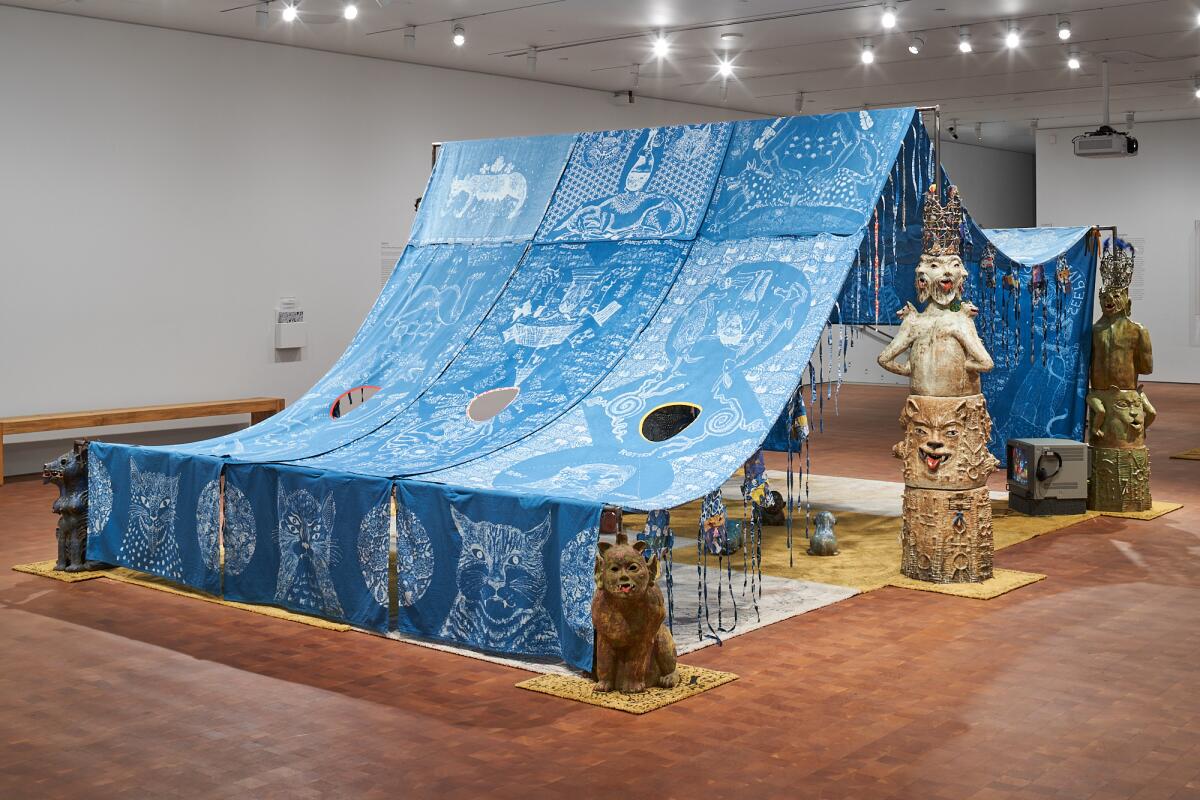
- Share via
We all need recession specials, so I’m currently working my way through the list of The Times’ most affordable restaurants from the 101 List. I’m Carolina A. Miranda, arts and urban design columnist for the Los Angeles Times, and I’m here for manakeesh and tacos dorados — as well as all of the essential arts news:
I can haz a spellbinding show
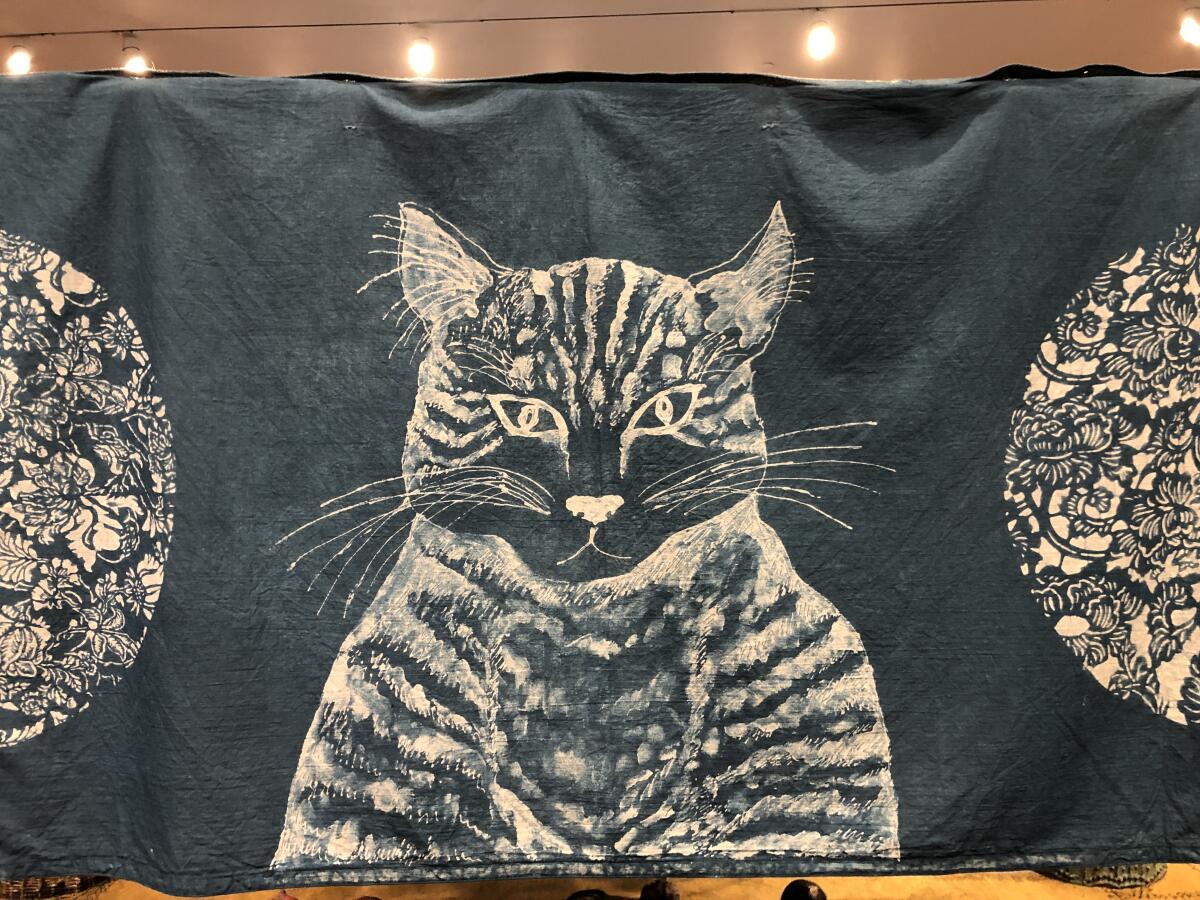
In 2014, I attended an event in the basement of Mack Sennett Studios in Silver Lake titled “The Beast and the Sovereign,” inspired by the animalistic visual themes that appear in Jacques Derrida’s lectures.
I didn’t take notes, but I remember a dance and a sculptural washbasin made to look like a gutted pig-monster. I also remember a fleshly feast that included grilled octopus and chicharrones, all lubricated by a robust amount of booze. What I most recall from that night, however, was a ceramic sculpture by L.A. artist Candice Lin that looked like a hybrid of sea creature and the torso of a woman’s body. Viewers could peer through a labial fold in the sculpture at an illuminated scene contained within. (Sorry, don’t remember the scene — too much feasting.)
Make the most of L.A.
Get our guide to events and happenings in the SoCal arts scene. In your inbox once a week.
You may occasionally receive promotional content from the Los Angeles Times.
Ever since that experience, I’ve always found myself enthralled whenever I stumble into Lin’s work. A 2017 exhibition at LACE featured watercolors from her “Sexual Lives of Savages” series, which showed feral barbarous women cavorting amid lush landscapes — work inspired, in part, by colonial art and European chronicles of the so-called New World. In 2018, a room-sized piece by Lin featuring an earthen mound planted with seeds and bearing the imprint of a human body materialized at the Hammer Museum’s “Made in L.A.” biennial.
Last year, she took over a gallery at Prospect.5 in New Orleans with a piece that dug into the history of a Mississippi River slaughterhouse town and fishing village inhabited by Filipino indentured laborers and the free Blacks known as maroons. In that piece, titled “Swamp Fat,” river clay covered the floor, and sculptures of gutted animals bore lard — which the viewer was invited to touch and put on their body.
Lin’s work draws heavily from historical research. However, its impact lands not in the head but the body: your sense of smell, your sense of touch and the senses that can’t be reduced to heaps of words. In an interview published in Ocula in January, Stephanie Bailey described Lin as a “historical alchemist.” It’s a phrase I will happily steal, for Lin’s work often feels like a spell.
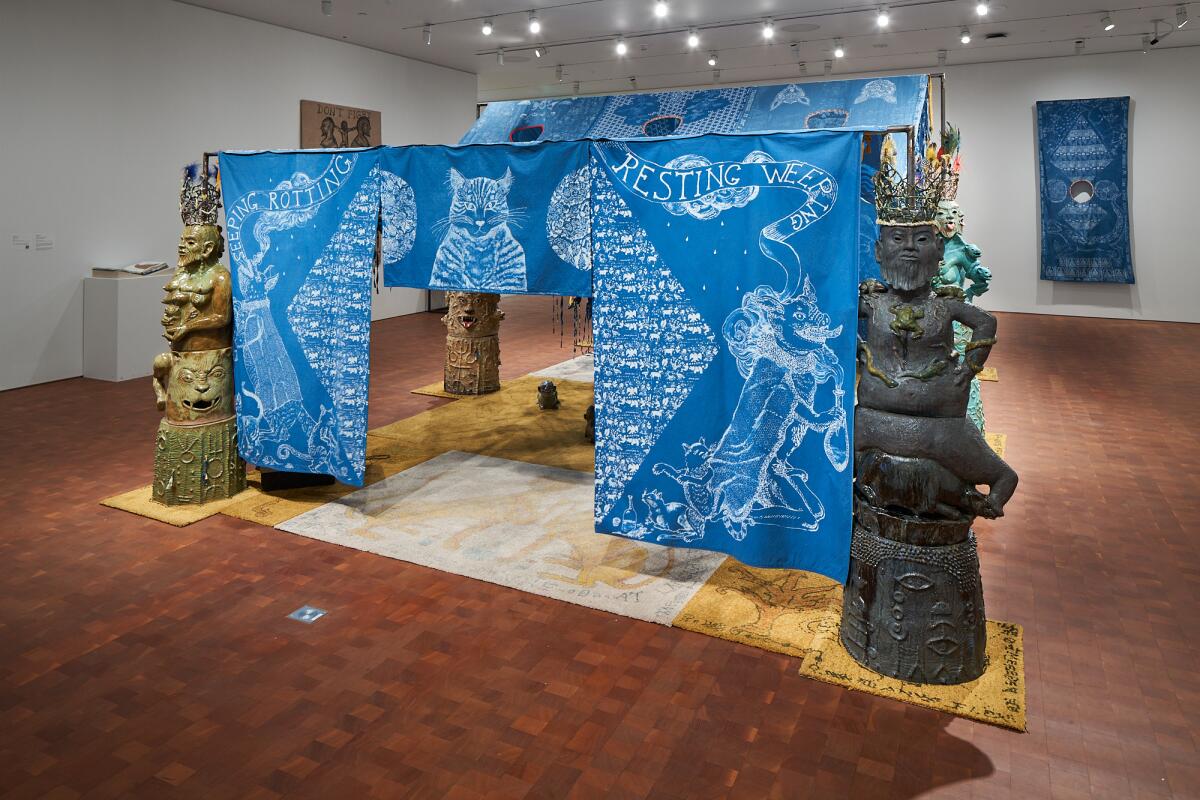
All of this is a very long way of saying that I was excited to see the installation by Lin that is on view at the Berkeley Art Museum and Pacific Film Archive. Titled “Seeping, Rotting, Resting, Weeping,” the show was organized by Victoria Sung at the Walker Art Center in Minneapolis and Dan Byers at the Carpenter Center at Harvard University, where the show was on view prior to arriving in the Bay Area.
Like Lin’s other work, it draws from material histories, casting a spotlight on the networks of global trade and colonialism that moved commodities such as indigo around the world. The artist used indigo to dye textiles that shelter a tent in the middle of the gallery. This protective structure bears stylized images of bodies, not to mention plenty of cats, and is surrounded by ceramic hybrid animal-human figures that function like totemic protectors. Within the tent, more cats — rendered as sculptures bearing human-ish faces — can be seen lying about. Visitors are invited to go lie about with them and watch a video that reads like a cat fever dream.
Elsewhere, Lin presents table sculptures that she dubs “Tactile Theaters.” In these, a pair of viewers are encouraged to take a seat before the work and make eye contact as they finger its contours. (Unfortunately, I was by myself in the gallery so was unable to meet anyone’s gaze, though I did feel the work’s sensuous folds.) Also on view is a video from 2021 that features a 3-D animation of a cat with milk-engorged teats leading a session of Qigong. Materializing on the screen are also various internet cat memes.
In wry and compelling ways, these bring together the artist’s interests in matrices of exchange — of materials and of ideas. (The kitty Qigong video reads like traditional Chinese medicine as digested by the ravenous capitalism of the Western “wellness” industry.)
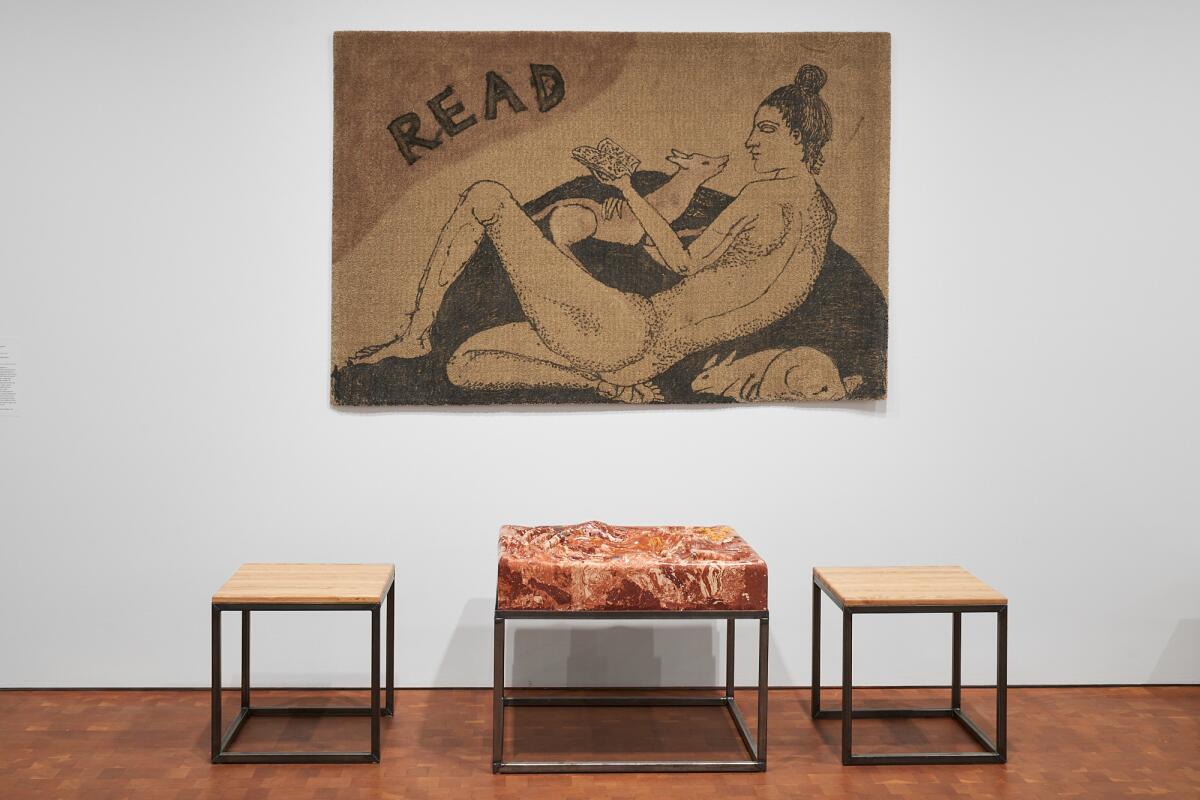
But the show is ultimately about being present in one’s own body.
The works in “Seeping, Rotting, Resting, Weeping” were produced in the early days of the pandemic lockdowns. In that way, they bring back some of its bodily states, such as the sheltering in place with elements of the familiar (like cats!). Part of the presentation includes Lin’s drawings journal from that period. Unfortunately, it wasn’t on view on the day that I visited — though it is reproduced, in part, in the show’s fantastic catalog, which features a page from March 14, 2020, three days after the World Health Organization declared COVID-19 a pandemic. On that day, Lin entered a pair of indigo swatches into the book, one of which bears the words “public grief” and shows figures crying.
But the installation also provides a counter to these moments of profound isolation, a time when we were all digitally imprisoned by Zoom. This is a show about bodies, our bodies, the ways in which they come into contact and the resonances they leave in their wake. Those bodies? They include lots and lots of cats.
“Candice Lin: Seeping, Rotting, Resting, Weeping,” is on view at the Berkeley Art Museum and Pacific Archive at UC Berkeley through Nov. 27.
In the galleries
In a time of unrelenting drought, every drop of water feels more valuable than gold. At Track 16 gallery, a group exhibition titled “Confluence” explores water issues related to the Los Angeles River. Organized by artist Debra Scacco (who also has work in the show) and featuring the work of nine artists, the exhibition, writes art critic Christopher Knight, is “modest but timely” — with works that dwell on “the typical inconspicuousness of critical water issues from city dwellers’ daily consciousness.”
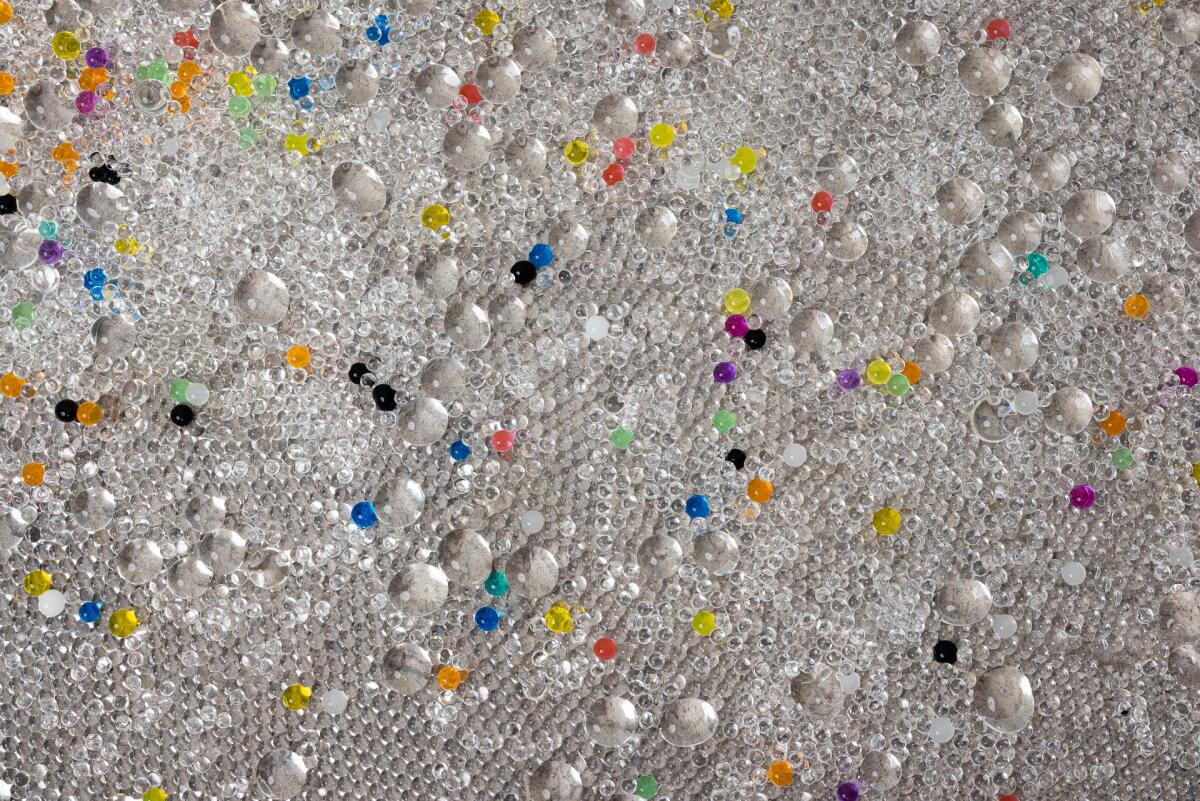
Scacco chatted with The Times’ Deborah Vankin about how the exhibition came together. “We realized that at the root of each of these topics is the attempt to dominate nature through channelization,” says Scacco, of the exhibition’s themes. “We discussed this focus with each artist and selected works that engage in at least one aspect of the human attempt to control the Los Angeles River and to treat water as a commodity to be owned.”
Sorta related: a juicy story about celebrity water-guzzling (think: Kardashian, Stallone) in the Las Virgenes Municipal Water District. “We’re asking them to not just minimize their water usage,” says the district’s spokesman Mike McNutt, “but we’re also asking them, in a way, to just completely rethink what is aesthetically pleasing.”
Enjoying this newsletter? Consider subscribing to the Los Angeles Times
Your support helps us deliver the news that matters most. Become a subscriber.
And since we’re on the subject of stars: The Times’ Meg James reports on an installation at ESMoA that remixes blockbuster movie imagery into a gallery-sized collage. The show, “Experience 51: Time,” features sketches, keepsakes and set pieces by Academy Award-winning production designer Rick Carter, as well as other artists’ interpretations of the movies he’s worked on, which include “Jurassic Park” and “Back to the Future.”
Plus, Diane Haithman reports on a new exhibition at the Academy Museum of Motion Pictures: “Regeneration: Black Cinema 1898-1971,” on view until April. The show, which was co-curated by the Academy Museum’s Doris Berger and Rhea Combs of the Smithsonian’s National Portrait Gallery, begins with representations of Black people in early cinema and culminates with pictures made in 1971 — such as “Shaft” and “Black Chariot.” Director Charles Burnett (“Killer of Sheep”), who served on the show’s advisory team, said the process of putting together the exhibition “has been eye-opening for me.”
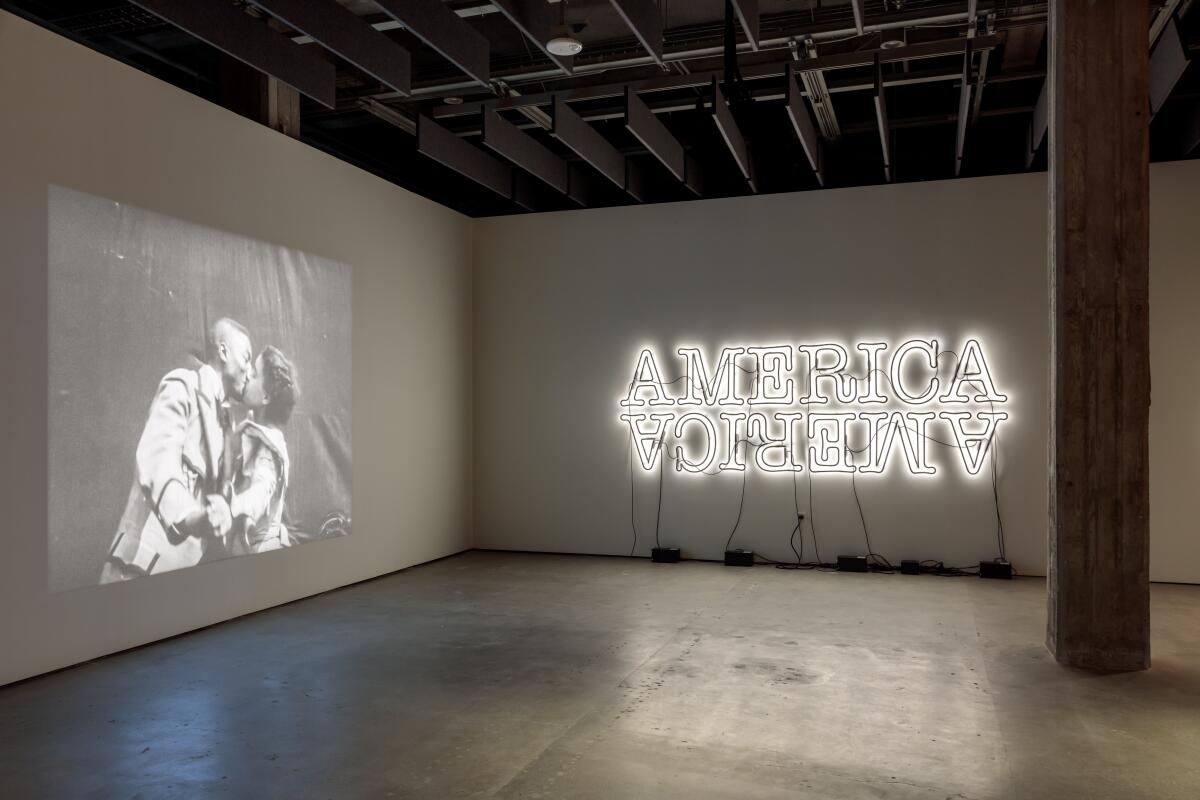
Germany’s Documenta quinquennial has become a vortex of controversy this year after antisemitic caricatures appeared in an installation and had to be pulled. This has led to conflicts over other works and participants in the show, which was organized by the Indonesian collective ruangrupa — in a way that brought a horizontal curation model that involved the work of collectives who then invited other collectives to participate.
There have been some interesting essays on the topic by critic Minh Nguyen in Art in America and Eyal Weizman, director of Forensic Architecture, in the London Review of Books, who write about how the issues in Kassel go deeper than a single banner.
It’s also worth revisiting Siddhartha Mitter’s review of the show.
Design time
Seventeen months ago, a rather unusual billboard popped up on the Sunset Strip designed by the L.A.-based architect Tom Wiscombe. Last week, New York Times contributor Joseph Giovannini did a major story on it, describing it as an “inviting chapel.” The story omitted a critical detail: In the spring, Wiscombe was put on administrative leave from SCI-Arc after students there launched a petition calling for his ouster as undergraduate program chair. In my column this week, I dig into the story — about the ways in which faculty at SCI-Arc employ student labor, an issue that is symptomatic of larger issues in the field.
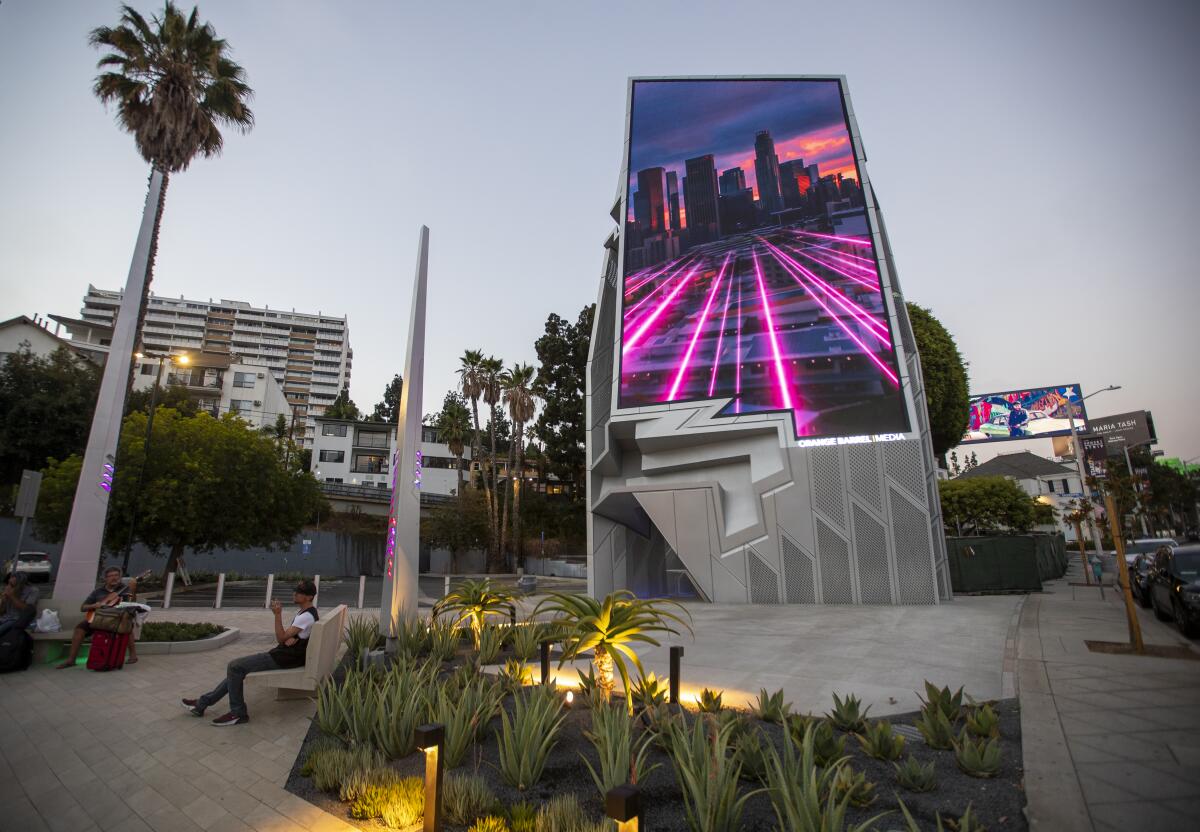
Crypto.com Arena is getting a refresh that will bring together two of the venue’s original architects, Dan Meis (now principal of Meis architects) and Ron Turner, who is the global director of sports for Gensler. Among the more intriguing transformations: Chick Hearn Court will be converted from a street to a pedestrian plaza. The Times’ David Wharton has all the deets.
Brad Pitt’s Make It Right Foundation has settled with owners of faulty post-Hurricane Katrina homes in New Orleans for $20.5 million.
Enjoy this sumptuous dive into the home of designer Peter Lai.
On and off the stage
Roger Q. Mason’s “Lavender Men,” which imagines an Abraham Lincoln brought back to life by queer magic to rekindle a relationship with a law clerk named Elmer E. Ellsworth, is having its world premiere at the Skylight Theatre. It’s a “handsomely wrought production,” writes theater critic Charles McNulty. “Mason’s rawness isn’t dramatically seamless,” he writes, “but it’s bracing to witness nonetheless.”
In 1991, actor Ed Waterstreet, who is deaf, founded a theater troupe for deaf actors called Deaf West. Over more than 30 years, that little troupe has “evolved into an internationally recognized powerhouse,” writes Times culture writer Jessica Gelt. “It has managed to do this while remaining relatively small: The company has only three full-time employees, including [artistic director DJ] Kurs, and this year is operating on a budget of about $850,000.” Gelt sat in on rehearsals for a new production of “Oedipus” that will be staged at the Getty Villa. “Intersectionality is where beautiful things happen,” Kurs tells her, “when deaf and hearing people come together in service of creating art.”
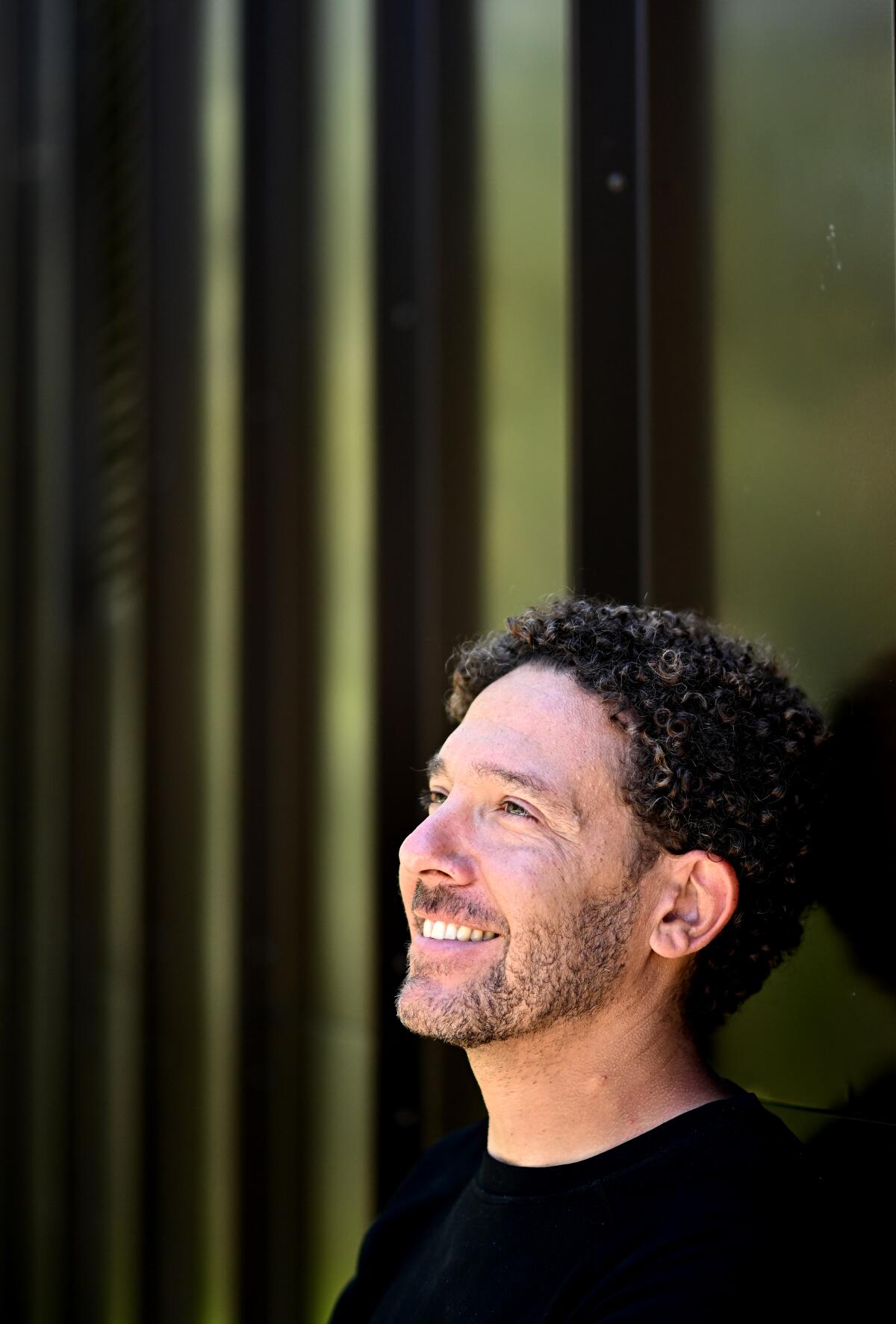
Essential happenings
I’ve always dug the sight of the Spring Street Community Garden, tucked between parking lots in downtown L.A. On Saturday morning, the Central Library’s Gardening Club is hosting an event at the site to talk gardening tips and the garden’s history.
If I were in the Bay Area, I would absolutely, positively be headed to the “Jeweled Rice” exhibition at Crisis Club Gallery in Oakland because I will always celebrate rice in all of its incarnations.
Plus, put this on your long-range calendar for next month: This year’s Fulcrum Festival, “Deep Ocean/Deep Space,” kicks off in locations around L.A. (and the Mt. Wilson Observatory) on Sept. 15. There will be dance, there will be sound, there will be performance — and it will be cosmic!
Moves
Dancer and choreographer Melissa Barak has been appointed artistic director of Los Angeles Ballet, the first solo artistic director since the company’s founding in 2006.

Historian and curator Andrea Gyorody has been named director of the Frederick R. Weisman Museum of Art at Pepperdine University. She has been serving as interim director since last fall.
Andrés Jaque, founder of the Office for Political Innovation, whom I wrote about many moons ago on the occasion of his solo show at REDCAT, has been named dean of Columbia University‘s architecture school.
Passages
Marta Palau, a Mexican sculptor whose work engaged feminist issues and textile traditions, has died at 88.
Tim Page, a photographer known for his searing images of the Vietnam War and his larger-than-life persona — he helped inspire the Dennis Hopper character in “Apocalypse Now” — has died at 78.

Tsuneko Sasamoto, one of the first women to work as a photojournalist in Japan and known for recording the country’s rapid postwar evolution, has died at 107.
In other news
— How Alexander Pushkin’s African great-grandfather shaped his worldview and his work.
— Lizzie O’Shea in the Baffler on how our A.I. dystopia is already here: It’s called the algorithm.
— I’m entranced by “Watȟéča,” a hypnotic video/performance piece by artist Cannupa Hanska Luger. (The video is the second large image from the top.)
— For independent dance artists in Ukraine, the body is an ultimate weapon — but also a repository of terrible grief.
— Jörg Colberg over at Conscientious has a really interesting piece on a new artist book, “300m,” by Ben Brody, that captures, in artful ways, the U.S. presence in — and hasty exist from — Afghanistan.
— A great profile of artist-poet Cecilia Vicuña, who is about to have a solo at the Guggenheim.
— An installation by Ani Liu at a Manhattan gallery explores the ways in which motherhood intersects with technology.
— Museums must post salaries in job ads in a new rule set by the American Alliance of Museums.
— This is wild: how a case of Photoshopped images in Architectural Digest has spurred an investigation into looted Cambodian relics.
— Speaking of which, Cambodian officials believe the Metropolitan Museum of Art may also hold looted art.
— Here are the coordinates for Michael Heizer’s “City.” (Essential background here.)
And last but not least ...
Listen to a black hole in space. Then read the review.
The biggest entertainment stories
Get our big stories about Hollywood, film, television, music, arts, culture and more right in your inbox as soon as they publish.
You may occasionally receive promotional content from the Los Angeles Times.




